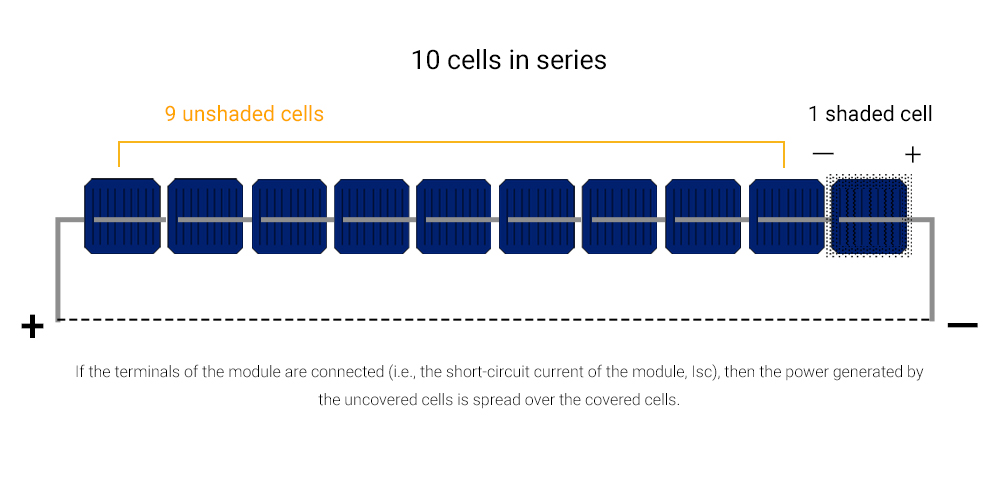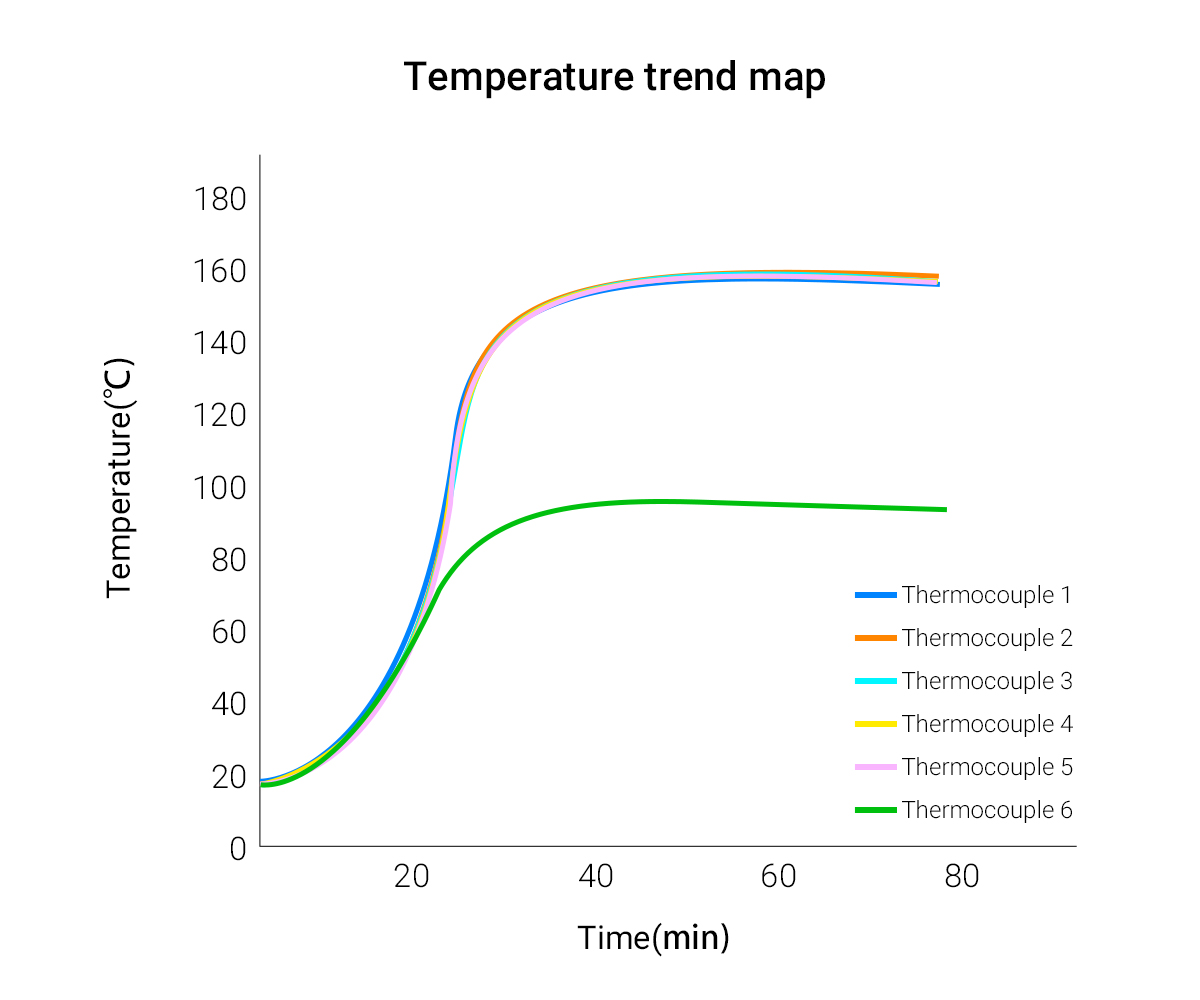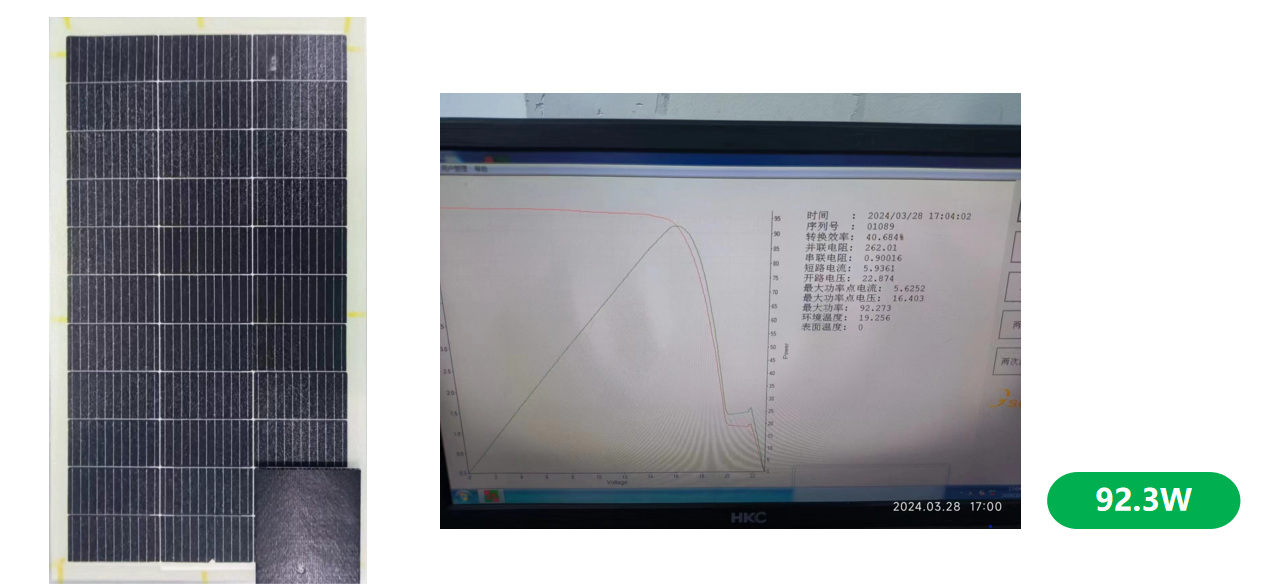In today’s ever-changing solar industry, the efficiency and durability of solar panels have taken center stage. The hotspot effect, a major challenge, not only affects panel performance but also poses safety risks, drawing widespread concern from industry experts and academic researchers.
This blog post offers a comprehensive analysis of the causes behind hotspots on solar panels, the origins of problematic cells, and the corresponding strategies to tackle these issues.
What Are Hot Spot Effects?
Hotspotting occurs in photovoltaic (PV) modules when the operating current exceeds the short-circuit current of shaded or defective cells, causing them to work in a reverse bias state. Instead of generating power, the cells become a heat source. This localized overheating can damage the cells, reduce their performance, and increase the risk of safety incidents.
As shown below, hotspotting happens when a string of high short-circuit current cells contains at least one low-current cell.

How Do Hot Spot Effect Affect Solar Panels?
The hotspot effect leads to localized overheating of solar panels, reducing their efficiency and potentially causing damage.
– **Efficiency Reduction:** When hotspots occur on solar panels, they increase the local temperature, which typically reduces the performance of the solar cells. Higher temperatures weaken the electron conductivity in photovoltaic cells, which affects the cells’ ability to generate power.
– **Thermal Expansion and Contraction:** Solar panels are exposed to photolytic and thermal expansion effects due to long-term sunlight exposure. This surface thermal expansion and contraction can cause structural issues, such as material fatigue and stress, which can lead to cracks or other problems.
– **Solar panels Damage:** Hotspots can also damage the internal electronic components of solar panels, such as battery connectors and wires, due to the high temperatures. This damage can decrease the overall performance of the panel.
– **Lifespan Affected by Thermal Stress:** Solar panels that experience high temperatures for extended periods may undergo frequent thermal stress. This stress can shorten the lifespan of the panels and reduce their reliability in solar power systems.

Causes for Hot Spot Effectss?
In solar panel assemblies, cells are connected in series. If a cell is partially shaded or inherently defective, its electrical output diminishes. This leads to a reverse bias due to the current flowing out from the normal cells, causing the impaired cell to heat up. Bypass diodes can help by diverting the current around the defective cell, but this isn’t a perfect solution. The causes of the hotspot effect may include shading, module defects, or uneven aging of cells, leading to localized uneven illumination and overheating in certain areas. The specific causes are as follows:
Partial Cell Aging: Over time, due to various factors such as uneven exposure to sunlight, individual solar cells within a panel may age, leading to an imbalance in cell performance. This can result in the formation of hotspots, as some cells degrade faster than others, impacting the overall efficiency of the solar panel.
Mismatched Series Panels: In solar panel installations with series-connected panels, a mismatch in the specifications or conditions of the panels can cause uneven power generation. This imbalance may cause some panels to operate at lower currents, making them susceptible to hotspot formation, especially during periods of high solar irradiance.
Faulty Bypass Diodes: Bypass diodes are key components that help mitigate the effects of shading on solar panels. If these diodes fail to function properly due to manufacturing defects or wear and tear, it could lead to ineffective shading relief, promoting the development of hotspots in shaded areas of the panel.
Shading: One of the primary causes of hotspots on solar panels is shading. When part of a panel is obstructed, the series connection of the cells generates a significant reverse bias voltage on the shaded cells. This can cause heat accumulation, temperature increases, and the formation of hotspots. Furthermore, shading reduces the overall efficiency of the panel since the shaded cells
Advancements in Hotspot Effect Research
A study published in the journal “Energy Procedia” made use of ANSYS simulations to examine the connection between hotspot temperatures and defects in solar cells. The study found that the temperature of hotspots and the number of cell defects were inversely related, and that the number of cell defects was tied to the power output of the module.
In-Depth Understanding Through Simulation and Experimentation
The study simulated the heat dissipation of cells under various shading conditions using MATLAB and ANSYS. The results showed that a 350-watt module with bypass diodes could reach temperatures as high as 200°C under 10% shading conditions, which can cause encapsulation failure. The hotspot effect can cause permanent damage, such as localized cell burning, solder joint melting, and aging of encapsulation materials, which can affect the output power and lifespan of photovoltaic modules. Therefore, IEC61215:2005 includes a hotspot endurance test to assess the capability of PV modules to withstand the effects of hotspot heating.
Design Considerations for Solar Modules
These insights show that designing photovoltaic modules to mitigate hotspot risks is important. Strategies include arranging cells to minimize shading effects and improving quality assurance processes to eliminate defective cells.
How To Avoid Hot Spot Effects ?
The study argues that the best way to reduce hotspots is to control defects strictly during cell sorting and circuit optimization for high-power modules.
It is crucial to choose high-performance solar panels. Firstly, high-efficiency solar panels can convert solar radiation into electricity more effectively, reducing energy loss and the severity of hotspot effects. Secondly, high-performance solar panels usually have lower temperature sensitivity, allowing them to maintain higher energy conversion efficiency in high-temperature environments, mitigating the negative impact of hotspot effects on performance. Therefore, it is important to choose solar panels with excellent performance, such as Topcon solar panels.
Built-in bypass diodes are also effective in preventing hotspot effects when solar panels are shaded. This feature allows current to bypass the affected areas in the presence of defects or shading, preventing the formation of hotspot effects and maintaining system performance. All Sungold solar panels are equipped with internal bypass diodes.

The correct orientation and installation of solar systems are essential to ensure uniform sunlight exposure to solar cells and avoid hotspot problems. By adjusting the orientation and tilt angle of solar modules, the energy capture efficiency of the solar system can be maximized. This design helps ensure that light energy is distributed evenly across the entire surface of the solar cells, avoiding shading and preventing overheating in certain areas, thereby improving the overall performance and stability of the system.
Cooling with air circulation is critical. Hotspots are often caused by heat accumulation, which can be exacerbated by factors such as restricted airflow within the solar panel system (e.g., a protective cover). To ensure proper system operation, adequate ventilation and airflow must be maintained to prevent panel overheating. Installing power optimizers is one of the best ways to prevent this, as they will automatically reduce electricity generation when needed to ensure stable production.
Regular cleaning of solar panels is also important. Dirty panels are more susceptible to hotspots. Additionally, it is important to ensure that trees, leaves, and other debris do not block direct sunlight to the solar panels to ensure optimal use of light energy. By using a combination of these methods, hotspot effects in solar panel systems can be effectively prevented, ensuring stable and reliable performance.
Final thoughts
Hot spots are a main concern for the safety and efficiency of solar panel components. The research cited in the references has laid the groundwork for understanding this issue and emphasizes the importance of industry practices aimed at minimizing hot spots to ensure the reliable and safe performance of solar panels.
Hot spots are a main concern for the safety and efficiency of solar panel components. The research cited in the references has laid the groundwork for understanding this issue and emphasizes the importance of industry practices aimed at minimizing hot spots to ensure the reliable and safe performance of solar panels.

























